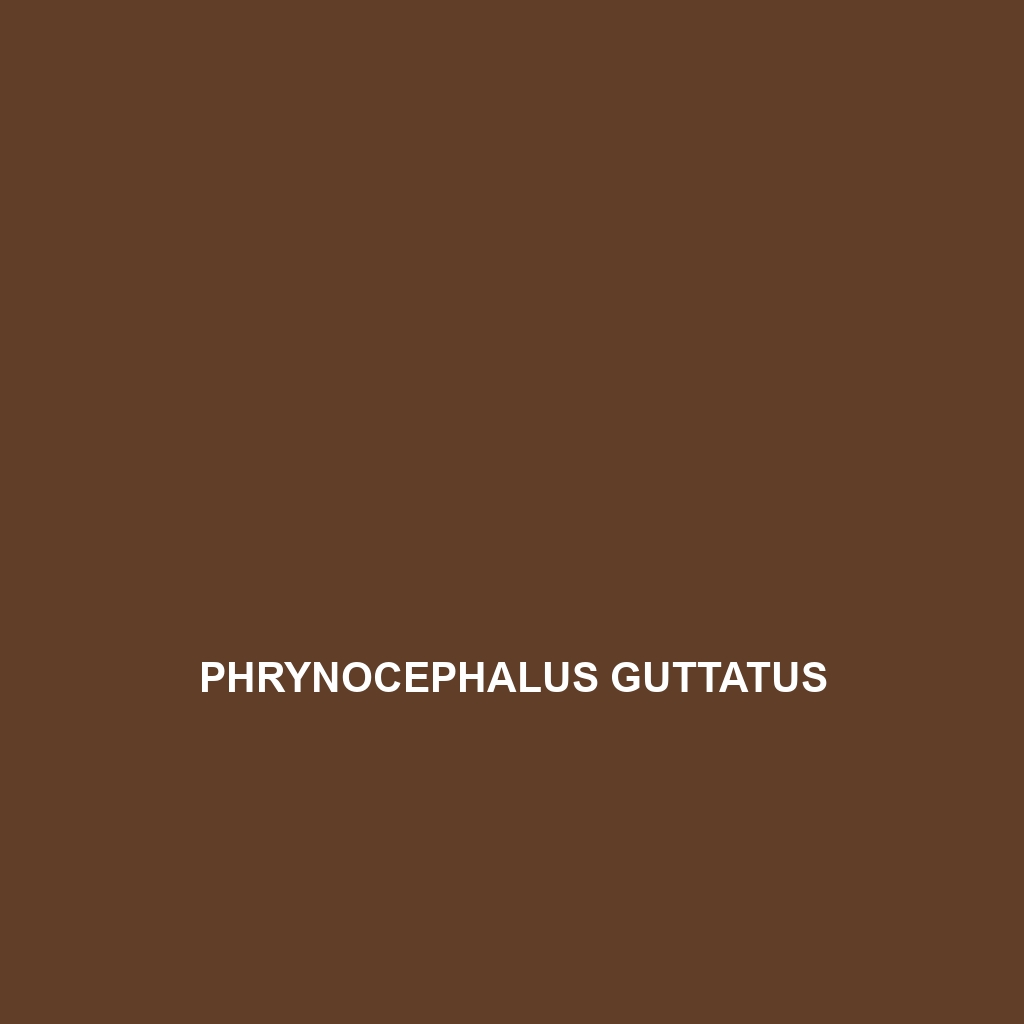Common Name
Phrynocephalus guttatus
Scientific Name
Phrynocephalus guttatus
Habitat
Phrynocephalus guttatus, commonly known as the spotted toad-headed agama, is primarily found in arid and semi-arid regions of Central Asia, including parts of Mongolia, Kazakhstan, and China. This species thrives in a variety of habitats, ranging from sandy deserts with sparse vegetation to scrubland and semidesert areas. The typical climate where Phrynocephalus guttatus is found includes low rainfall, extreme temperature fluctuations between day and night, and strong winds, all of which influence the ecological dynamics of these habitats. The species has adapted to these challenging environmental conditions, reflecting its resilience as a terrestrial lizard.
Physical Characteristics
Phrynocephalus guttatus is a small to medium-sized lizard, often measuring around 8 to 14 centimeters (3 to 5.5 inches) in total length. This species is characterized by its flattened body and broad head, which are well-suited for a life spent primarily on the ground. The coloration of Phrynocephalus guttatus varies across individuals, typically ranging from sandy beige to light brown, adorned with distinctive dark spots and bands that provide effective camouflage against the desert surroundings. One unique feature includes the presence of spiny scales on the occiput and nape, which may serve as a form of defense against predators.
Behavior
Behaviorally, Phrynocephalus guttatus exhibits a variety of fascinating traits. Primarily diurnal, these lizards are active during the daylight hours, basking in the sun to regulate their body temperature. They are known to exhibit solitary behavior, though individuals may congregate in areas with abundant food. As for their mating rituals, males engage in dazzling displays, which include push-ups and head-bobbing to attract females during the breeding season. Interestingly, they also have a unique adaptation for evasion—when threatened, they may burrow quickly into the sand to escape danger, showcasing their agility in this harsh environment.
Diet
The diet of Phrynocephalus guttatus is primarily insectivorous, which means they feed mainly on insects. Their diet consists of various small invertebrates, including ants, beetles, and grasshoppers. They exhibit opportunistic feeding behavior, consuming whatever prey is available in their environment. Occasionally, they may also indulge in plant matter, making them somewhat omnivorous in their dietary habits. This flexibility in their diet allows Phrynocephalus guttatus to thrive in conditions where food sources can be sporadic.
Reproduction
As for reproduction, Phrynocephalus guttatus has a well-defined mating season that occurs in late spring to early summer when temperatures are favorable. After mating, females lay eggs in a shallow nest burrow, usually containing 6 to 12 eggs. The incubation period lasts approximately 30 to 50 days, depending on environmental conditions such as temperature and humidity. Upon hatching, the young lizards are independent and exhibit adult characteristics almost immediately, showcasing their self-sufficiency from a very young age.
Conservation Status
The conservation status of Phrynocephalus guttatus is currently classified as Least Concern, according to the International Union for Conservation of Nature (IUCN). This classification suggests that the species does not face significant immediate threats. However, habitat loss due to human activities, including land-use changes and climate change, poses potential challenges for their future survival. Furthermore, conservation efforts are necessary to monitor populations and protect their habitats to ensure they remain stable.
Interesting Facts
One interesting fact about Phrynocephalus guttatus is its ability to change its color to some extent, allowing it to better blend into its surroundings, thus enhancing its camouflage against predators. Additionally, these lizards have excellent vision, which aids them in spotting both prey and potential threats. Their adaptation to hot and arid environments is remarkable, enabling them to thrive in some of the most challenging landscapes.
Role in Ecosystem
Ecologically, Phrynocephalus guttatus plays a crucial role in its environment as both a predator and prey species. By feeding on insects, they help maintain the balance of insect populations, contributing to the overall health of their ecosystem. As prey for larger animals, such as birds of prey and snakes, they also serve as an important food source. Thus, Phrynocephalus guttatus can be considered a significant component of the ecological web, supporting biodiversity within its arid habitat.
